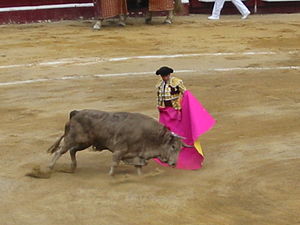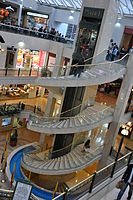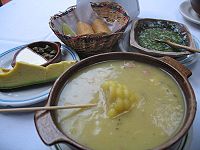- Colombian culture
-
See also: History of Colombia
Culture of
Colombia
Art
Cinema
Cuisine
Dance
Folklore
Literature
Music
Radio & Television
Sports
Theater
Many aspects of Colombian culture can be traced back to the early culture of Spain of the 16th century and its collision with Colombia's native civilizations (see: Muisca, Tayrona). The Spanish brought Catholicism, African slaves, the feudal encomienda system, and a caste system that favored European-born whites. After independence from Spain, the criollos struggled to establish a pluralistic political system between conservative and liberal ideals. The conservatives supported the involvement of the Catholic Church in the state while liberals favored the separation of these. The conservatives managed to outsource public education to the Catholic Church and for many years the church controlled the country's education system. Both parties engaged in multiple civil wars resulting in a slow development of the country and the isolation of regions until the end of the 19th century. Ethno-racial groups maintained their ancestral heritage culture: whites tried to keep themselves, despite the growing number of illegitimate children of mixed African or indigenous ancestry. These people were labeled with any number of descriptive names, derived from the casta system, such as mulatto and moreno. During this time it was normal for white individuals to marry a sibling or close cousin to maintain their inheritance within the family. Blacks and indigenous people of Colombia also mixed to form zambos creating a new ethno-racial group in society. This mix also created a fusion of cultures. Carnivals for example became an opportunity for all classes and colors to congregate without prejudice. The introduction of the bill of rights of men and the abolishment of slavery (1850) eased the segregationist tensions between the races, but the dominance of the whites prevailed and prevails to some extent to this day.The industrial revolution arrived relatively late at the beginning of the 20th century with the establishment of the Republic of Colombia. Colombians had a period of almost 50 years of relative peace interrupted only by a short armed conflict with Peru over the town of Leticia in 1932.
During the 1940s, Colombia started to develop its tourist industry having as main attraction the Caribbean coastal city of Santa Marta and the Magdalena river basin main towns which also had a flourishing economy and an important flow of immigrants from Europe and the Middle East due to World War II.
With the advancement of the ideas of communism around the world, Colombian radical liberal politicians and thinkers adopted these ideas and adapted to their political rhetoric. Tensions between the United States and the USSR during the Cold War revived tension between local Colombian liberals and conservatives, polarizing Colombian society. Radical communist guerrillas surged sponsored by the USSR while the US government aided the Colombian government.
Influences
 Villa de Leyva a historical and cultural landmark of Colombia
Villa de Leyva a historical and cultural landmark of Colombia
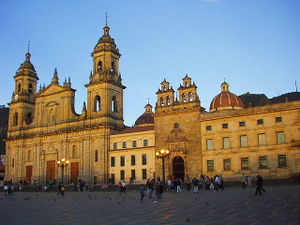 Cathedral in downtown Bogota, heritage of Spanish architecture
Cathedral in downtown Bogota, heritage of Spanish architecture
Aboriginal influences
The various cultures of the indigenous inhabitants of Colombia were decimated by the Spanish. Today, only around one percent of Colombians live and consider themselves as indigenous. Nonetheless, many elements of indigenous culture live on in Colombia's cuisine, music, folklore, and language.
Multicultural elements
See also: Afro-Colombians and Criollo (people)The essence of Colombian culture lies in the mixing of Spanish, indigenous, and African cultures. The greatest expression of the mélange is perhaps the Carnival of Barranquilla, whose rhythm is the cumbia, and which was proclaimed by UNESCO in November 2003 as one of the Masterpieces of the Oral and Intangible Heritage of Humanity. The culture of Spain is still very dominant in Colombia: the layout of towns, bull fighting, holy week processions, and the "refined" dialect of Bogotá are part of its legacy. Afro-Colombians have historically been marginalized from society. Nonetheless, they have contributed greatly to Colombian culture, including its music, dance and folklore. Cumbia is said to be derivative of the cumbe dance of Equatorial Guinea. Small numbers of Roma or "gypsies" are scattered throughout the country. Sephardic Jews and Ashkenazi Jews exist in several of the larger cities; Bogotá has five synagogues.[1] Germans settled in parts of Santander, including Bucaramanga. They also brought the accordion to Valledupar, which would become a key instrument in the very popular vallenato music genre.
Geography, climate, and immigration
See also: Geography of Colombia and Climate of ColombiaMost Colombians live in the Andes, high above sea level where climates range from temperate to cool (the highest parts get snow).The treacherousness of the terrain and sheer variety of climates made communication and travel very difficult, and helped foster intense regionalism which is tropical.
Between the three mountain ranges or cordilleras are two large valleys whose rivers (Magdalena River, Cauca River) link the interior to the coastal ports. These lowlands are thick with rainforests and interspersed rushing tributaries, waterfalls, and steep inclines. The Andes themselves are in parts volcanic, jagged and covered in glaciers. Other parts are more hospitable, such as the tableland of much of Cundinamarca (including Bogotá) and Boyacá (called in Spanish the Altiplano Cundiboyacense), which has a climate similar to the Argentine pampas. Medellín is in the Aburra valley, on the central mountain range, at a lower altitude than chilly Bogotá, which gives it an "eternal spring"-like climate. The Caribbean coast, Colombia's gateway to the outside world before jet travel, is separated from the Andes by mosquito-filled, marshy wetlands, while the Pacific coast is pock-marked with its own marshes and is one of the wettest places on earth.
Colombia did not receive substantial immigration after the period of Spanish rule. An exception is the Atlantic port city of Barranquilla. Relatively small groups of Lebanese, Italian, Dutch, German, Catalan, Syrian-Lebanese-Palestinian, French, and Chinese immigrants settled in the city and played a large role in its development. Shakira, a native of Barranquilla, is of Lebanese and Italian ancestry. Bogotá received some immigrants from Europe in the period following World War II; the eccentric former mayor of Bogotá and semiotics professor Antanas Mockus is the son of Lithuanian immigrants. Most Chinese in Colombia originally came from Panama, where they helped in the building of the railways of the Panama Canal, to help in building the train and road routes between the Pacific port of Buenaventura and the interior city of Cali. Today, in the surrounding area of the Cauca Valley, virtually every town has a Chinese restaurant.[1]
A few Japanese families settled in Colombia, inspired by the bucolic description of the Cauca Valley in Jorge Isaacs' novel María. The heads-of-household of Japanese descent would be interred in prisons near Zipaquirá during World War II.[2]
Foreign influences
 Shopping mall in Barranquilla
Shopping mall in Barranquilla See also: Globalization and Immigration to Colombia
See also: Globalization and Immigration to ColombiaColombian politicians, intellectuals, and members of elite society turned to France for inspiration in the period following independence from Spain. Colombian's civil code (adopted in 1887) is based on the Napoleonic Code. French architect Gastón Lelarge (1861–1934) designed many of the public edifices in Bogotá as well as the cupola of the church of Saint Peter Claver in Cartagena.[3]
Starting in 20th century, North American culture had increasing influence on the culture of Colombia. Shopping malls and tract housing in the style of North American suburbs are very popular and are considered status symbols. Hollywood films, American fashions, and English-language popular music are also popular. Influences from elsewhere in the Spanish speaking world are also present, especially in music and television.
In the late 19th Century US and to a lesser amount European businesses started to taken an interest in the northern part of Colombia where they started to grown Bananas on large pieces of land. This had a big influence on local government and the term Banana Republic is also here relevant. The Town of Aracataca (Macondo) was the center of these new undertakings later so well described in Gabriel Garcia Marquez's masterpiece; One Hundred years of Solitude...
Education
Main article: Education in ColombiaPublic education
Public education in Colombia is cheap and compulsory for students coursing Primary Studies (Básica Primaria) consisting of five years, from first grade to fifth grade. Classes begin in February and finish in November. Students usually begin primary at age of six, and finish it at age of ten. Secondary Studies (Básica Secundaria) are not free and consists of six years, from sixth grade to eleventh grade. Classes begin in January and finish in November.During the eleventh grade students apply for the ICFES test, similar to the SAT test, which is needed to apply for superior studies. Public schools in Colombia usually attend only half a day, since there are so many kids and so few schools and teachers, they divide the day in two, having one set of kids attend in the morning from 7 to 12 pm and one set in the afternoon from 1 to 6 pm, like having two schools in the same facility. The government has started a night school program for those students who work during the day, though. Some teachers may work at two or three different schools during the day or at the same school during the whole day.The students can go to classes in the morning, from 7 am to 12 pm, in the afternoon, from 1 pm to 6 pm,or at night from 6:30 to about 10:00( some night schools hours may be shorter). Most students of public schools are from low income families and cannot afford superior studies. Such students can choose a free course in the SENA (Servicio Nacional de Aprendizaje) or study in educative corporations (corporaciones educativas) which offer very few titles of universities, and technical degrees. There are only a few public universities where students can get an education for free or very little money.
Private education
Private education in Colombia is more reliable than public education, but is more expensive. In intermediate and small cities, monthly costs can range from USD 50 to USD 450. In bigger cities, costs can be USD 300 or more, however, the most expensive schools are not always the best. The classes begin in the morning (usually at 7:00) and finish in the afternoon between 1:30 and 4:00 pm. The school year starts in January or February and finishes in November, for Calendar A schools. The school year in calendar B schools begins in August and finishes in June. Most schools expect from children to learn to read and write before beginning primary and most schools are bilingual, however, all schools, public and private must teach English as a second language. The teaching of English is more intensive in private schools, some students are fluent before beginning middle vocational studies. Most private schools assure that all the students can apply for superior studies in a normal university. Due that most students come from middle and upper class families, they can afford superior studies. Private universities are expensive, a semester can cost USD 1500, most private universities are in Barranquilla, Bogotá, Medellín, Bucaramanga and Cali.
Living patterns
Income disparity
Main article: Poverty in ColombiaDue to widespread corruption, economic instability and high unemployment over the last century or so, Colombia has developed a huge rift between two economic classes (Low and High) with an almost nonexistent, but increasing middle class, particularly in the Bogotá and Medellín areas.
Family
The family is, as it is with nearly all of Latin America, a highly important institution to Colombians as engraved by the traditional Roman Catholic church teachings. Members of the extended family are close and children rarely move far away from their parents. There is a deep sense of familial responsibility that stretches through many generations.[citation needed]
Traditionally, men were usually the head of the household, in charge of earning most of the family's income while women were responsible for cooking, housework and raising children. However, as in most cultures around the world, the dawn of the 20th century brought forth a great empowerment for women who were given a right to vote during the 1950s rule of dictator Gustavo Rojas Pinilla. The Constitution of 1991 gave a wider opportunity for women and today the majority of families (regardless of economic class) have two working parents due to the need of an income to sustain a family.
At a child's baptism, the parents of the child will choose godparents, padrinos. A child's padrinos will play an important role in his life, giving advice, and when needed, financial support.
Divorce
Before 1974 marriage was exclusively performed by the Roman Catholic Church and other religious groups until the government of Alfonso López Michelsen (1974–1978) approved the civil marriage that could only be ended after a legal divorce. It was only after the Colombian Constitution of 1991 that Colombian lawmakers admitted divorces for marriages performed by the Catholic Church.
On June 9, 2005 the Colombian congress approved the Express Divorce law in an effort to eliminate paperwork and waits. These previously took an average of 6 weeks, a judge and lawyers, with the new law the two parties had to only agree against a notary public without the need of a lawyer.[4][5] According to a study by the Universidad Externado divorce in Colombia has been constantly increasing since the 1950s
Political attitudes
See also: Politics of ColombiaThe Politics of Colombia take place in a framework of a presidential representative democratic republic, whereby the President of Colombia is both head of state and head of government, and of a multi-party system. Executive power is exercised by the government. Legislative power is vested in both the government and the two chambers of congress, the Senate and the House of Representatives of Colombia. The Judiciary is independent of the executive and the legislature.
Food
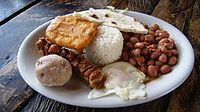 The Bandeja paisa (Paisa tray) is the traditional dish of the Antioquia Department.
The Bandeja paisa (Paisa tray) is the traditional dish of the Antioquia Department. Main article: Colombian cuisine
Main article: Colombian cuisineThere is a large variety of dishes that take into account the difference in regional climates. For example:
- In the city of Medellín the typical dish is the bandeja paisa. It includes beans, rice, ground meat or carne asada, chorizo, fried egg, arepa and chicharrón. It is usually accompanied by avocado, tomato and sauces.
- In the city of Cali, the most traditional dish is "sancocho de gallina" - a soup composed mostly of chicken, plantain, corn, coriander, yuca root, and other seasonings.
- In Bogotá and the Andean region, ajiaco is the traditional dish. It is also a type of soup made of chicken, potatoes, and flavoured with a locally grown herb called "guasca". Traditionally, cream and capers are added just before eating. Both soups are served with white rice, salads with a hint of lemon, avocado, or plantain chips, sweet or salty. For breakfast people often eat changua, a milk, scallion and egg soup.
- In the Caribbean coast, spicy cooking, with fish and lobster, is practiced. Coconut rice is a common dish along the coastal cities.
- In the Llanos, barbecued meat, such as the "ternera llanera" is common, and also typical river fishes like the "amarillo".
- In the Amazonas, the cuisine is influenced by Brazilian and Peruvian traditions.
Inland, the dishes reflect the mix of cultures, inherited mainly from Amerindian and European cuisine, and the produce of the land mainly agriculture, cattle, river fishing and other animals' raising. Such is the case of the sancocho soup in Valledupar, the arepas (a corn based bread like patty). Local species of animals like the guaratinaja, part of the wayuu Amerindian culture.
- In the Tolima region the Tamales Tolimenses are a delicacy. These tamales are made of a corn dough and feature peas, carrots, potatoes, rice, chicken, pork and various spices. They are wrapped in plantain leaves and boiled for three to four hours. Pandebono for breakfast with hot chocolate.
On the Islands of San Andres, Providencia and Santa Catalina the main dish is rondon, a seafood dish made of coconut milk, fish, conch, cassava root (yuca), sweet potato, white yams, and pumpkin seasoned with hot peppers and herbs. They also have a crab soup which is considered a delicacy. It is made with the same ingredients as rondon, without the fish.
Festivals in Colombia
Main article: Festivals in ColombiaFolklore
Main article: Colombian folklore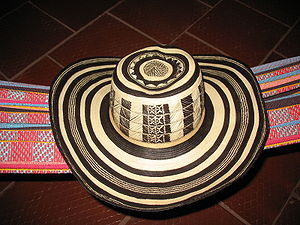 The vueltiao hat, a handicraft of the Zenú people, is a national symbol
The vueltiao hat, a handicraft of the Zenú people, is a national symbol
Colombia has many traditional folk tales and stories about legendary creatures which are transmitted orally and kept for next generations to come. Some of them are common with other Latin American countries. The Colombian folklore has strong influences from Spanish culture, with elements of African and native American cultures.
Sex roles
Sex roles in Colombia, specially in some segments of population, are rigidly defined. Machismo and marianismo pervade in certain cases. Few men take on housekeeping or child-rearing duties, which are reserved for women. Economic instability has increased the number of single, female-headed families, and gender discrimination in wages and hiring has lead many single mothers and their daughters to turn to prostitution. Abortion is legal in some cases,[2] and divorce was legalized in the past decade.[3]
Women
See also: List of beauty pageants in ColombiaIt is common for Colombians to extol the beauty of their countrywomen. Companies, municipalities and even prisons hold over a hundred beauty contests showcasing women annually, more than any other country.[4] Popular soap operas like Sin Tetas No Hay Paraíso ("Without Tits There Is No Paradise") and Yo Soy Betty La Fea ("Ugly Betty") have satirized the over-emphasis placed on women's sexual attractiveness, fashion and grooming.
LGBT Population
Main article: LGBT in ColombiaIn the last decades, the LGBT population has expressed in favour of its rights. The Constitutional Court (Corte Constitucional) has recognized some rights of the LGBT population, like the right of social protection for the homosexual couples and civil unions.[5]
Painting
Main articles: Colombian Art and Colombian handicraftsColombians have been producing art for thousands of years. Ornate golden figures and jewelry from millennia ago have been discovered by both ruthless conquistadors and careful archaeological digs. In the colonial time, the painting was characterized by the works of the three Figueroa, pioneers of this art: Baltasar de Figueroa, the old; Gaspar the Figueroa, his son and Baltazar de Figueroa, the young. Gaspar was the teacher of important artists, lie Gregorio Vásquez de Arce y Ceballos. José María Espinoza Prieto, painter and engraver, also is important for his portraits, landscapes and caricatures. Epifanio Garay is highlighted, specially by his portraits. After the war of independence, in 1819, the Colombian art still is dependent of the figurative. Some persons explain that delay in the evolution of the Colombian artistic styles doing reference to the geography of the country, that make difficult a contact and dialogue between the different creative tendencies In the decades between 1920 and 1940, Marco Tobón Mejía, José Horacio Betancur, Pedro Nel Gómez, Ignacio Gómez Jaramillo, Santiago Martínez Delgado and Alipio Jaramillo created some dynamics in the elaboration of murals. They were influenced by the Mexican art, although with neoclassic and Art Nouveau characterists. At the beginning of the 1940 decade, are created works that was new in Colombia, inspired in the post-impressionism and the academic french style. Many historians of art believe that the Colombian art only began to has a distinctive character in the half of 20th century, with a new point of view, integrating the cultural and artistic traditional elements with the concepts of the art in 20th century. Ignacio Gómez Jaramillo, for example, combine the new techniques with cultural elements, in his Portrait to the Greiff Brothers. Pedro Nel Gómez, highlighted in the drawing, the water color, the fresco, the oilpainting and the sculpture in wood, stone and bronze, shows, for example in "Autorretrato con sombrero" (1941), his familiarity with the works of Gauguin and Van Gogh. In other works, he reveal the influence of Cézanne. Alejandro Obregon, considered by many as the father of the Colombian art (most by his originality), has been acclaimed by critics and the public because of his painting of national landscapes characterized by violent strokes and the symbolic and expressionist use of animals (specially birds, like the condor). His work is influenced by Picasso and Grahan Sutherland. In last years, some Colombian artists, such as Fernando Botero, Enrique Grau, David Manzur, Luis Caballero, Santiago Martinez Delgado, Ignacio Gomez Jaramillo, Débora Arango, and have received international fame, awards and wide public acclaim.
Religion
Main article: Religion in ColombiaSee also: Status of religious freedom in Colombia, Christianity in Colombia, Protestants in Colombia, Roman Catholicism in Colombia, and Islam in ColombiaStudies suggest that about 90% of Colombians are Roman Catholic. However, Colombians are notable for their acceptance of other creeds and faith as well as sexual preferences based on the simple principle of "do no harm" and tolerating and welcoming anyone who follows such guideline. Also, there are many Christians in Colombia.
Literature
Main article: Literature of ColombiaGabriel García Márquez, winner of the Nobel Prize for Literature in 1982, is from Aracataca, Colombia. His novel Cien Años de Soledad is recognized as a landmark of the literary movement known as "magical realism (realismo mágico)". Other important writers are Jorge Isaacs, who wrote "María", Gonzalo Arango, founder of the "Nadaismo" movement, Álvaro Mutis, winner of the Cervantes Prize, Fernando Vallejo, winner of the Rómulo Gallegos prize, José Asunción Silva, precursor of Latin American romanticism, Raúl Gómez Jattin, Efraím Medina, Andrés Caicedo, the poets Piedad Bonnet and María Mercedes Carranza, Aurelio Arturo, the novelist Germán Espinosa and Rafael Chaparro Madiedo. The most important literary magazines are El Malpensante, Arcadia, Número, La Movida Literaria, Universidad de Antioquia and Puesto de Combate.
Colombian theatre
- Iberoamerican Theater Festival
Festival de teatro Gitanos en Macondo - first week of september in Aracataca, Madalena.
Film and television
See also: Cinema of Colombia and Television in ColombiaThe interest for the film production came late to Colombia. Vicente and Francisco Di Doménico, of Italian origin, were the pioneers in the films production. In 1912 is inaugurated the first movie theater in Colombia: the Salón Olympia, with a capacity of three thousand people. The most outstanding directors of the film production are Sergio Cabrera, Felipe Aljure, Luís Ospina, Víctor Gaviria and Carlos Mayolo. Between the most recent proposals we find to Andy Baíz and Juan Felipe Orozco, director of "Al final del espectro". The work of Dago García and Rodrigo Triana is in a commercial line.
Sports
See also: Sports in ColombiaFútbol (soccer) is the most popular sport in Colombia. Baseball has become popular in recent years; it is especially popular along the coast and is strongly promoted all around the country. Edgar Rentería is an example of a famous Colombian baseball player, but Soccer is still the main sport of the country. Boxing and fighting sports are also very popular amongst the male population and all of these are practiced avidly by the youth.
An ancient game called Tejo, inherited from the "muisca natives", is also played. The object of tejo is to throw a small metal disk at a gunpowder detonator in a small circular area. The winner is calculated by the number of explosions compared to number of throws.
Comedy
Main article: Colombian comedyColombian comedy's original birthplace is the radio since this was the first original mass media with wide coverage of the national territory rendering radio a very important medium for the promotion of comedy. A distinctive representative of Colombian comedy on the radio and who was praised by generations even before television became popular was Colombian comedian Gullermo Zuluaga, better known by his stage name Montecristo.Since then many other comedians and storytellers have shaped Colombian's concept of what is humorous in many cases at the expense of the tragedies of war, economic distress and misbehaved politicians.
Music
Main article: Music of Colombia-
Shakira Colombian superstar
Modern Colombian music is a mixture of African, native Indigenous and European (Spanish) influences, as well as more modern American and Caribbean musical forms, such as Trinidadian, Cuban, and Jamaican. The national music of Colombia is said to be vallenato and cumbia.
Cumbia is a mixture of Spanish and African music, the latter brought by slaves. The style of dance is designed to recall the shackles worn around the ankles of the slaves. In the 19th century, slavery was abolished and Africans, Indians and other ethnic groups mixed more fully. Styles like bambuco, vallenato and porro were especially influential. When the waltz became popular in the 19th century, a Colombian version called pasillo was invented. International Latin, a type of pop ballad, and salsa music are best-represented by Charlie Zaa and Joe Arroyo, respectively.
Music and dancing are very popular in Colombia, with dozens of popular vibrant styles. The most popular local musical styles are Vallenato, salsa, Merengue, Cumbia and Bambuco. The latter is a very complicated dance with many differently named steps.
Colombian rock developed after an influence of Rock en Español generating fusion of Rock Music with traditional Colombian music and other musical styles.
The musical genre of Colombian pop music has been growing recently with artists like Fonseca, San Alejo, Lucas Arnau or Mauricio y Palo de Agua. Pop with strong traces of traditional Colombian music is also currently rising. Los De Adentro and Maía represent this trend. Many Colombian artists are recognized internationally including among others, Shakira, who is the most recognized Colombian artist in the world.
Dancing to reggaeton became also very popular in Colombia during the first decade of the 21st century.
Symbols
See also: National symbols of ColombiaSee also
- Latin American culture
- Hispanic culture
- List of Colombians
- List of players from Colombia in Major League Baseball
- Carnival in Colombia
- Festivals in Colombia
References
Bibliography
- Londoño Vélez, Santiago (2001). Colombian Art: 3,500 Years of History. Bogotá: Villegas Editores. ISBN 9589698271.
- Safford, Frank; Mauricio Palacios (2002). Colombia: Fragmented Land, Divided Society (Latin American Histories). Oxford: Oxford University Press. ISBN 019504617X.
External links
- (Spanish), Luis Ángel Arango Library digital collection
- Music Llanera
- Dancing Devils in Corpus Christi Festival, Sierra Nevada
Latin American culture North America 
Central America Caribbean - Antigua and Barbuda
- Bahamas
- Barbados
- Cuba
- Dominica
- Dominican Republic
- Grenada
- Haiti
- Jamaica
- Puerto Rico1
- St. Kitts and Nevis
- St. Lucia
- St. Vincent and the Grenadines
- Trinidad and Tobago
South America - Dependencies not included.
- 1 Defined as a semi-autonomous territory.
Categories:
Wikimedia Foundation. 2010.

